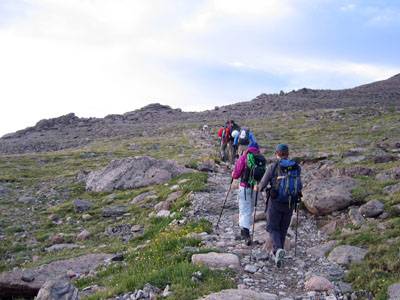| 016 | Pacing | 2008-12-08 |
Have you ever found yourself quickly hiking a steep trail only to find at the end of the day that you are so tired that you spend more time sitting on a log than walking. Or, perhaps setting a good even pace, but taking lots of breaks, slowing your pace when necessary, and enjoying the hike, until in the afternoon when you find yourself caught in a massive thunderstorm above tree line.
Good pacing prevents the hare from walking too fast and the tortoise from walking too slow.
How do you get better at pacing?
Know Your Destination - is your hike a means to get to the lake you’re wanting to fish, or the ends making a leisurely walk to nowhere in particular. How much time have you allotted for the hike. Set realistic, goals.
Research the Trail - how many miles, mileage intervals, important landmarks or junctions, type of terrain, grade of the trail, and exposure. If the hike you are planning is nine mile roundtrip to the top of bald summit, you average a mile an hour uphill, thunderstorms roll in at twelve, and you leave the trailhead at eight - you are asking for trouble.
Hiking Partners - know the speed, fitness, and quirks of your partners. You are only as fast as the slowest person in the group. At every break, put the slowest person in front to set the pace.
Gearing Up - carry the essentials in a comfortable pack and wear suitable clothing. Unless you are hiking in the desert leave the cotton at home. Dress for the weather plus pack rain gear and essentials - remembering an extra warm layer.
Eating and Drinking - find a hydration system that is easy for you to use, be it water bottles or a bladder and food that is compatible with your effort. Drink. Plan out where and when you are going to get your next water. It is hard to tell how much is left in a bladder until it is empty. I always carry a small backup water bottle or bag in my pack just in case. And Eat. You have to put food in the furnace that you can digest.
Weather - check the weather before leaving the trailhead but also check the weather patterns for the season. It is amazing how regular weather can be in the mountains. If storms hit everyday at one while you are gazing at the heights from the valley below, then when you are finally in the mountains, the storms are probably going to hit around one - ready or not here I come.
Practice - check your pace with a pedometer or GPS and your pulse with a heart rate monitor. I guess it is time to enter the 21st century and get the high tech gear to help track your training.
Be a Leader - formulate and execute a plan to set an effective pace. Every group is different, so the leader has to be flexible. Do your homework and plan for things that could alter the schedule. Even when you hike solo you need a leader in your group!
Setting a good pace is part of being a good leader. The pace I set is at a speed which I know I can walk all day and the only “pack off” breaks are for clothing adjustments. I drink and eat while walking. Continual movement is my style, but yours might not be. Whatever style you use, set a good pace, be safe, and have a good time.
Happy trails.
